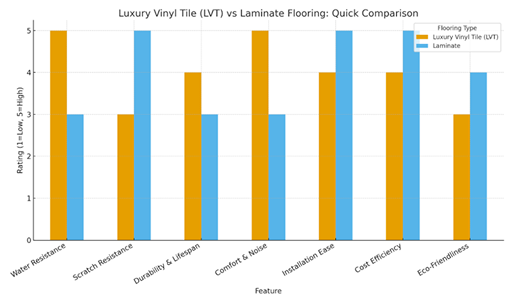When choosing between Luxury Vinyl Tile (LVT) and Laminate flooring, homeowners often face a decision that can be confusing. Both offer stylish, cost-effective alternatives to hardwood and tile, but their construction, durability, applications, and performance differ. This guide compares LVT and Laminate flooring, reviews the top five brands, and outlines the best use cases, technical specs, and benefits.
The comparison is based on four major evaluation categories

Shaw Floors – Known for premium LVT with realistic textures and durable finishes, including CoreTec.

Mohawk Industries - Offers both LVT (SolidTech) and Laminate (RevWood) with waterproof technology.

Armstrong Flooring – Strong heritage brand with reliable LVT and Laminate lines.
.svg)
Pergo – Pioneer of Laminate flooring; now also offers luxury vinyl collections.

Mannington – A family-owned U.S. company highly rated for its design-forward LVT and eco-conscious practices.

For Norman Carpet & Flooring customers, both are excellent alternatives to hardwood, but the choice depends on whether moisture protection or scratch resistance is the priority.
Contact UsLVT is a waterproof vinyl-based product designed for use in wet and high-traffic areas, whereas laminate is a wood-based product that’s water-resistant but not waterproof.
Luxury Vinyl Tile is better because it is 100% waterproof and won’t swell or warp.
Laminate flooring typically offers superior scratch resistance compared to LVT, making it a better choice for homes with pets.
Yes. Both can be DIY-installed using floating click-lock systems, though glue-down LVT may require professional installation.
LVT lasts 15–25 years, while Laminate lasts 10–20 years with proper maintenance.
Yes. Both are compatible with heated flooring systems; however, always follow the manufacturer's guidelines.
LVT is softer, warmer, and quieter underfoot than Laminate.
Laminate is often more eco-friendly due to recycled wood fiber cores, though many LVT brands now use low-VOC and recycled vinyl content.
Laminate has a lower upfront cost, but LVT offers better water resistance and lifespan, which may provide better long-term value in high-moisture homes.
Connect with our team of designers and experts.
Contact Us